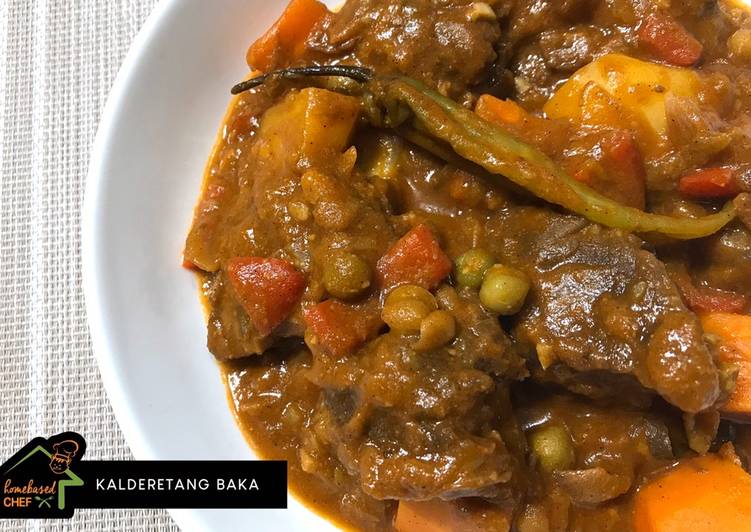
Hey everyone, it’s me, Dave, welcome to our recipe page. Today, we’re going to make a distinctive dish, beef caldereta. It is one of my favorites. For mine, I will make it a little bit unique. This will be really delicious.
Beef Kaldereta is a main stay in any Filipino Kitchen. It is a type of beef stew cooked with tomato sauce and liver spread. Ingredients such as potato, carrots, bell peppers, and olives are also utilized when.
Beef Caldereta is one of the most well liked of recent trending meals in the world. It is simple, it’s quick, it tastes delicious. It’s appreciated by millions every day. They’re fine and they look fantastic. Beef Caldereta is something that I have loved my whole life.
To get started with this particular recipe, we must first prepare a few components. You can cook beef caldereta using 16 ingredients and 5 steps. Here is how you cook it.
The ingredients needed to make Beef Caldereta:
- Prepare 1/2 kilogram Beef Cubes
- Get 4 cloves Garlic
- Take 2 pieces Red Onion
- Make ready 1 piece Carrot
- Get 2 pieces Potato
- Get 1 piece Red Bell Pepper
- Make ready 70 grams Tomato Paste
- Prepare 1 1/2 tablespoons Peanut Butter
- Make ready 1/2 teaspoon Ground Black Pepper
- Make ready 2 pieces Finger Chili
- Make ready 1 tablespoon Pickle Relish
- Make ready 3 tablespoons Green Peas
- Prepare 1 tablespoon Rock Salt
- Take 1 tablespoon Fish Sauce
- Make ready 3 liters Water
- Prepare 2 tablespoons Canola Oil
Vegetables may include tomatoes, potatoes, olives, bell peppers, and hot peppers. Beef Kaldereta (Caldereta) is a popular Filipino stew that is served during parties and holidays. There are so many great Filipino stews and a couple of my favorites that I've shared before include chicken. Beef Kaldereta (or Caldereta) is a Filipino spicy tomato-based beef stew loved by many Filipinos.
Instructions to make Beef Caldereta:
- BOIL THE BEEF UNTIL TENDER. I use a manual pressure cooker to tenderize the beef. - DISCLAIMER: If you are going to use a pressure cooker, make sure to read and follow the instruction manual of your cookware.
- Prepare the vegetables. While boiling the beef cubes: Wash all the vegetables. Peel and chop the garlic. Peel and slice the red onion. Peel the carrots and potatoes then cut into 1-inch wedges or cubes. Soak the potatoes in water to prevent them from turning brown in color. Cut off the stem of the red bell pepper, remove the seeds and slice into pieces.
- COOK THE CALDERETA. In a large pan over medium heat, sauté the garlic and red onion in canola oil for about 2-3 minutes. Add the boiled beef cubes, season with salt & pepper, and sauté for 5 minutes. Add the carrots, pickle relish, and around 5 ladles of beef broth; cover and simmer for 5 minutes.
- Add the potatoes, red bell pepper, finger chili, and 5 more ladles of beef broth; cover and simmer for 5 minutes. Mix in the tomato paste and peanut butter, until fully diluted, followed by the green peas and fish sauce.
- Reduce heat to medium-low and simmer with occasional stirring for 20 minutes or until the sauce thickens to your preferred consistency. Adjust with salt and pepper according to taste. Simmer for another 5 minutes. Remove from heat. Serve with hot steamed rice.
Traditionally, Caldereta is prepared using goat meat. But since it is rather difficult to come by, I opted. Boil the beef until tender, in the water to make a nice beef broth. Add pineapple juice and onion Beef Caldereta is a Filipino Kaldereta Recipe that uses beef. Caldereta or Kaldereta is a classic filipino dish in which every filipino household has its own version in cooking this recipe.
So that is going to wrap it up for this special food beef caldereta recipe. Thank you very much for your time. I’m sure that you will make this at home. There is gonna be more interesting food at home recipes coming up. Don’t forget to save this page on your browser, and share it to your loved ones, colleague and friends. Thanks again for reading. Go on get cooking!


